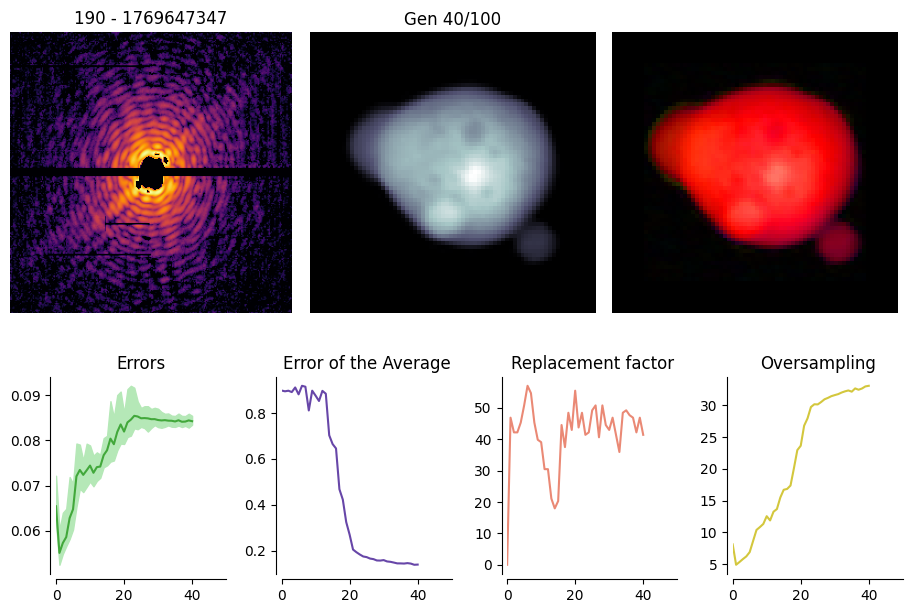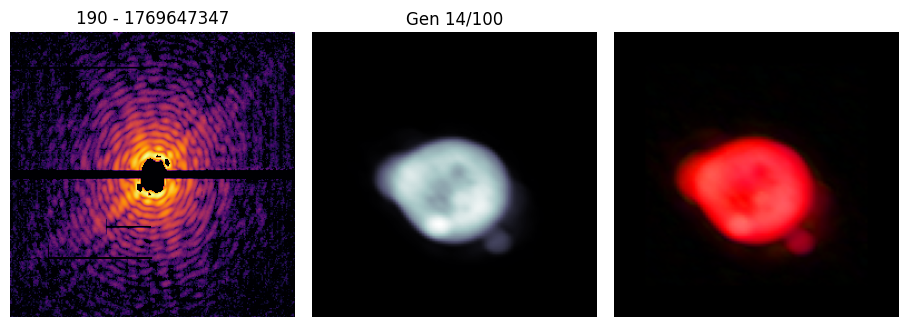Running a reconstruction asynchronously
It is often needed to monitor the reconstruction process while it takes place. However, the spring.MPR.run() method blocks the interpreter during the process, making it impossible to inspect the reconstruction while it is ongoing.
The spring.MPR class provides a further method which allows to run a reconstruction asynchronously, i.e without blocking the interpreter.
To perform the process in an asynchronous way, the Settings and the Pattern are prepared in the usual way:
import numpy as np
data = np.load('data/example_B_1.npz')
from spring import Pattern, Settings
patt = Pattern(pattern=data['pattern'],
mask=data['mask'],
center=data['center'],
pid=data['pid'],
cropsize=1024,
size=256,
satvalue=3e4)
sett = Settings()
sett.set('IA','it', 50).set('init','supportsize',90).set('global','gpus',1);
The MPR process can be now started but, instead of using the MPR.run() method, the MPR.runasync() function is called:
from spring import MPR
# Blocking call
# rec = MPR(pattern=patt, settings=sett).run()
# Async call
MPR(pattern=patt, settings=sett).runasync()
The function immediately returns, and the reconstruction is performed in the background by a child process.
Monitoring the reconstruction process
As the reconstruction is executed in the background, the MPR.runasync() method isn’t printing any output and the function immediately returns.
For the monitoring and control of the reconstruction it is then necessary to use a helper tool, spring.hypervisor. The object can be imported as it follows:
from spring import hypervisor as hv
The info() method allows for a quick inspection of the current status:
hv.info()
Running: 190-1769647347
Empty queue.
The livelog method reports the live status of the process. It is automatically updated in the background by a child process, leaving the console free to accept further commands. The command is a switch, meaning that it starts a live logging if the livelogging is not running, or it switches it off if it is already running
hv.livelog()
Selected GPUs:
- NVIDIA GeForce RTX 3090 (Id: 0, load: 0%)
Initializing solver... Done.
Initializing algorithms... Done.
Initializing population... Done.
... Running main loop ...
- - - - - - - - - - - - - - - - - - - - -
RUNNING 190-1769647347 [####------] 40%
The liveplot method shows the current result of the ongoing reconstruction. It is automatically updated in the background by a child process, leaving the console free to accept further commands. Also this command is a switch, meaning that it starts the live plotting if not already running, otherwise it stops it.
hv.liveplot()
Starting live plotting

The reconstruction at the current step can be directly accessed as a spring.Result object by calling hv.get(). In the following example the plot() method of the Result is called, to plot the reconstruction.
hv.get().plot()

The live plotting can be interrupted by calling again the liveplot() method
hv.liveplot()
Stopping live plotting... Done
The current reconstruction process can be interrupted in the following way:
hv.stop()
Terminating running MPR process... Done
Warning It is important to use the
stop()method of the hypervisor to stop the asynchronous reconstruction. If the kernel is manually stopped the behavior is undefined and the kernel has probably to be restarted
If a new MPR.runasync() call is made, the new reconstruction process is queued for execution after the currently running one.